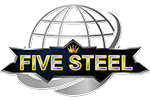In the current steel pipe market, hot dipped galvanized steel pipe is very popular among people because of its cost effective, maintenance-free corrosion protection system that will be able to last for decades even in the harshest environments. Technically speaking, the zinc layer of the hot dipped galvanized pipe is more corrosion resistant than the bare iron and steel. However, due to its special processing technology and high production costs, hot dipped galvanized pipe has a higher steel pipe price than other common pipes in the steel market.
Galvanizing is simply coating of zinc over steel products. Like paint, galvanized coating protects steel products from corrosion by forming a barrier between the steel base and the environment, but galvanizing goes one giant step further than paint. As a professional steel pipe manufacturer, we suggest that paints are properly applied to effectively restoring full corrosion protection to the weld areas in certain cases. Generally these paints are available in either spray cans or in containers suitable for brush or spray application.
In most cases, hot dipped galvanized steel pipe repair involves the most common types of damages or deterioration to piping system, such as internal and external corrosion, as well as situations where the damages are extensive. Regarding some cold rolled steel pipes, the touch-up and repair of hot dipped galvanized steel coatings is important to maintain uniform barrier and cathodic protection as well as ensure longevity. Although the hot dipped galvanized coating is very resistant to damage, small voids or defects in the coating can occur during the galvanizing process or due to improper handling of the steel after galvanizing. Touch-up and repair of galvanized steel is simple whether newly galvanized or in service for years. The practice is the same, but there are more restrictions to the allowable repairs on a new product than one that has been in service. The main restriction in the specification for repairing newly galvanized material is the size of the area which is outlined in the product galvanizing specifications. And another tenet of the specification for touch-up and repair is the coating thickness of the repair area.
Hot Dip Galvanizing is generally accomplished by two methods, both of which immerse or coat the metal with a liquid zinc bath after various processes. This protective coating is the interdiffusion of zinc and iron, which will last for many years. However, if you product needs cutting, welding or otherwise fabricating, it is proposed to be fabricated first, and then galvanized.
Send your message to us:
Post time: Jul-09-2018





